Image
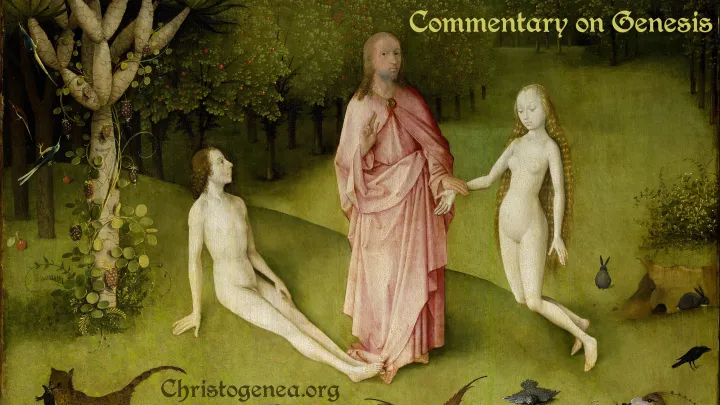
Christogenea is 100% reader supported. If you find value in our work, please contribute and help to keep it going! See our Contact Page for more information!

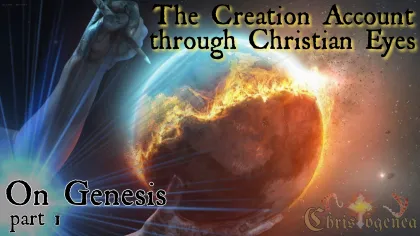
On Genesis, Part 1: The Creation Account through Christian Eyes
Here we are going to venture a commentary on the Book of Genesis, which, Yahweh God be willing, shall certainly require many months to complete. Some years ago we did a series of discussions here titled Pragmatic Genesis, and we may draw on some of that, or at least repeat ourselves somewhat because our opinions have not changed. So for that same reason, I will probably also repeat things which I have presented in other papers as well, and even some things of which Clifton Emahiser had also written. But most of our past work in Genesis was written only for the purpose of refuting certain heresies which are found in either Christian Identity circles or in the denominational churches. While perhaps I may mention some of those heresies as we progress through the chapters of Genesis here, I will try not to dwell on any of them at length, so as to be a distraction.
Some years ago I also wrote a paper titled On Biblical Exegesis. There I asserted that in order to understand the Old Testament, and Genesis especially, one can only do so through the lens of New Testament understanding, allegorically speaking. In other words, one can only understand Genesis through an understanding of the words of Christ both in the Gospel and in the Revelation. That is primarily because Genesis is not a complete history of what is popularly perceived as the “world”, nor does it offer a complete understanding of the state of the “world” when the Adamic man was created. This is first evident in the words of Matthew in chapter 13 of his Gospel where, after having recorded some of the parables of Christ, he wrote: “34 All these things Yahshua had spoken in parables to the crowds, and without a parable He spoke nothing to them, 35 that that which was spoken through the prophet would be fulfilled, saying: ‘I shall open My mouth in parables; I shall bellow things kept secret from the foundation of Society!’” The apostle was citing the 78th Psalm, but we shall see that this is also evident in subsequent chapters of Genesis itself.
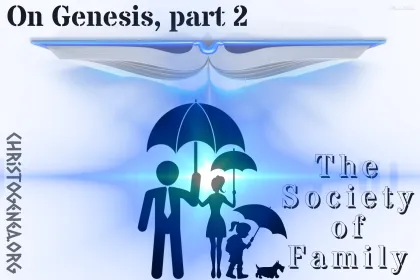
On Genesis, Part 2: The Society of Family
In our first presentation of this commentary on Genesis we ended with Genesis chapter 2 verse 3, as we consider those first few verses of this chapter, along with chapter 1, to be the first account of the creation of Yahweh God. Now as we commence with chapter 2, and through to the end of chapter 4, we shall begin to discuss the second creation account in Scripture. While this second account naturally follows the first in the text, the things which it describes actually parallel the later portions of the first account, the events which had been related on the sixth day of the creation of God. So this is also an example of a Hebrew parallelism, where something is described twice consecutively in a phrase, a sentence, or even in a longer passage, so that multiple aspects of a subject can be portrayed and explained more precisely. There are other examples of such parallelisms using entire passages in Biblical literature, and another one of significance is found in Genesis chapters 10 and 11. Ezekiel chapter and 28, and chapters 38 and 39 contain examples of others. Here in Genesis, while the first creation account provides a Godly worldview which laid a general foundation for the organization of a society, here we will see a foundation laid for the organization of a Godly family, which is the primary communicative unit of every prosperous society.
However before we begin to review and comment upon the text of this account in Genesis, there are a few aspects of it for which we should provide a preliminary discussion. That is because there are many errant concepts of the creation of Adam which throughout history have accommodated the Jews, who falsely claim to be the protagonists of the Old Testament, or the Roman Empire, as the fourth century Roman Catholic Church was organized to suit its whims, and now today it accommodates the modern diversity agenda. However in light of Genesis itself, especially in chapters 6 through 15, the concept that all of the hominid races on the planet were descended from this single man Adam are patently false, absolutely ludicrous, and do not withstand even the most basic historical or Scriptural scrutiny.
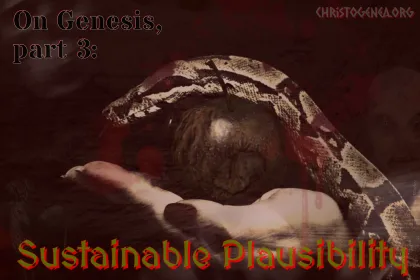
On Genesis, Part 3: Sustainable Plausibility
Here we shall continue our discussion of what we have described as the second creation account of Genesis, which is found in chapters 2 through 4, commencing with our commentary on Genesis chapter 3. As we have asserted in relation to the creation account of Genesis chapter 1, it serves to provide a basis for the foundation of a godly society. Then this second account, which begins with verse 4 of Genesis chapter 2, provides a basis for a godly family, which is the primary social unit of that godly society. Laying the foundation for a society of family, after Adam was commanded not to eat of the Tree of the Knowledge of Good and Evil it had also defined a proper marriage as he found that he had no suitable helpmate among all the beasts of creation. For that reason Eve was created, whereupon Adam himself had described a legitimate marriage as the union of a man with a woman of his own flesh and bone, a woman of his own kind or race, rather than of any of the other creatures in the garden.
Of course, Yahweh God had already foreseen the creation of woman, as it is declared in Genesis chapter 1 that “male and female created He them”, so Genesis chapter 2 further explains that creation process, which is not fully realized until the events come to pass which are described in Genesis chapter 5. Now, as this second creation account continues, it moves past the details of the creation of the Adamic man “male and female”, and begins to explain the reasons for the historic circumstances of man, who was initially created for the purpose of having dominion over the earth and everything in it, but who was quickly reduced to necessity, having to toil at hard labor in order to merely survive.
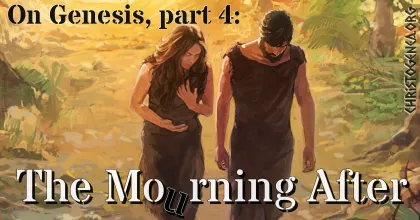
On Genesis, Part 4: The Mourning After
Here we shall discuss the latter half of Genesis chapter 3 and the consequences realized for sin which become evident on the mourning after, which is a pun that alludes to the consequences outlined in the punishment of Adam and his wife for their sins. The phrase the morning after is defined as “a period, as in the morning, when the aftereffects of excessive self-indulgence during the previous evening are felt…” or “a moment or period of realization in which the consequences of an earlier ill-advised action are recognized or brought home to one.” But here we have used the word mourning instead, because it also describes how Adam and Eve must have felt as those consequences were declared by Yahweh their God, and since we ourselves also have a right to lament those consequences because they have adversely affected all of Adam’s descendants throughout history, as Paul of Tarsus had explained at length in chapter 5 of his epistle to the Romans.
In our last presentation, Sustainable Plausibility, we made the assertion that our Genesis interpretation is valid only so long as it is upheld throughout the entire Scriptures, but if it is upheld then it must be true and correct. With that, we demonstrated the meanings of the expressions found in the opening verses of Genesis chapter 3 from similar expressions which had been employed elsewhere in Scripture and also in other ancient literature, which do indeed reveal that the metaphors and allegories are euphemisms for sexual activity, and that illicit sexual relations certainly are the cause for the fall of the Adamic man. Now as we proceed through Genesis, among other things we hope to continually demonstrate that the Scriptures certainly do substantiate this interpretation, and therefore that it must reflect the true meaning as it was intended by the Author, Yahweh God Himself.
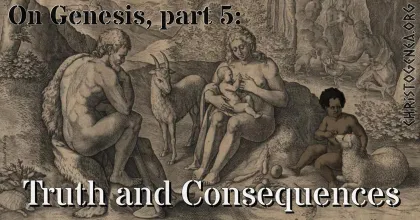
On Genesis, Part 5: Truth and Consequences
Discussing Genesis chapter 3 and The Mourning After, which is a pun in reference to the consequences of the deceiving of Eve and the subsequent fall of Adam and the circumstances which they would suffer for their sin, we had seen three explicit statements which all acknowledge the fact that at the time when their punishment was announced, Eve had already been pregnant. These statements are found in verse 15 and the reference to the two seeds, in verse 16 where Yahweh God had then informed Eve of the sorrow of her conception, indicating that she had already conceived, and finally in verse 20 where we read that “Adam called his wife's name Eve; because she was the mother of all living.” In this last statement it is absolutely manifest that Adam must have understood the significance of the earlier statements made to both the Serpent and Eve, and therefore he had also acknowledged the fact that she had already conceived, for which reason he chose for her a name signifying that she was “the mother of all living.”
Perhaps one of the greatest barriers to a proper understanding of Scripture, or maybe what has really been the greatest historical psyop, are the chapter and verse divisions which were added to our Bibles in the 13th century. Although men have divided the Bible into sections in one scheme or another for centuries before that, and at least as early as the 4th century, the familiar chapter divisions are often not very well placed, and many of the verse divisions are nonsense, as they often even split sentences. Then the result of these artificial divisions is that countless Christians read one verse of Scripture, they draw conclusions from that one verse by which they then govern their very lives, and as they do so they generally ignore the wider context in which those particular verses are found. Often their conclusions are ignorant of, or even contrary to, what the Scripture is actually teaching, and even more ominously, they are contrary to the commandments of God. (The vision of Peter in Acts chapter 10 is a prominent example, since it actually has nothing to do with clean and unclean food.)
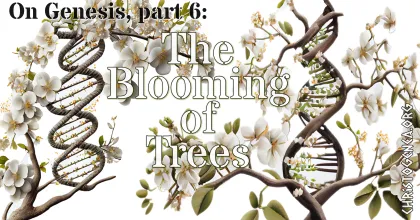
On Genesis, Part 6: The Blooming of Trees
In our last presentation of the Book of Genesis, Truth and Consequences and the opening verses of Genesis chapter 4, we hope to have once again fully established as fact the consequences of Eve’s sin, as it is described in Genesis chapter 3, where three times it was acknowledged that she had already conceived, and that therefore, in spite of the surface reading of Genesis 4:1, she was already pregnant when “Adam knew his wife”. Doing this, we cited several other Scriptures, both apocryphal and canonical, which are in agreement with this interpretation. But there is no Scripture in canon which explicitly disagrees with it, and therefore our witnesses must stand, and Cain must have been the literal son of the “wicked one”, as the apostle John had explained in his first epistle. With this understanding it also must be admitted that Genesis 4:1 cannot be a record of Eve’s conception, as she was already impregnated where she had been admonished in Genesis chapter 3. For that same reason Adam had already called her name Eve because “she was the mother of all living”, and in that manner he had also acknowledged that she was already with child.
But Adam, having accepted his wife’s sin, was also compelled to accept what was in her womb, and even after his punishment was declared, he may not have even been fully cognizant of the troubles which his sin would cause him in the future. So it is apparent that for that reason, Adam had raised both Cain and Abel as his own sons, and the immediate consequences of the sin in the garden once again became apparent in the murder of Abel. The name Abel is interesting in this regard, as the Hebrew term הבל, hebel or habel (Strong’s #’s 1891-93), as a verb is to breathe, and as a noun it means breath or therefore also vanity, since breath is representative of something that is transitory. However the words for breath also provide expression for the concept of spirit in both Hebrew and in Greek. Although Abel’s life may have been of brief duration, as Paul of Tarsus had explained in chapter 11 of his epistle to the Hebrews, “4 By faith Abel offered to Yahweh a better sacrifice than Cain, through which he was accredited to be righteous, having testified of Yahweh by his gifts, and being slain because of it he still speaks.”
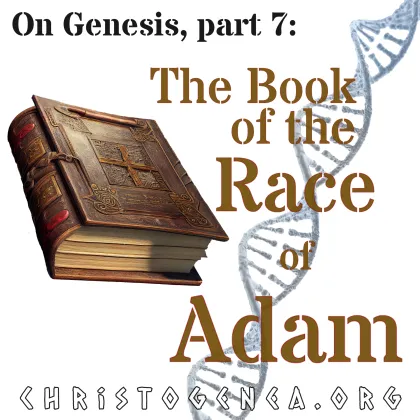
On Genesis, Part 7: The Book of the Race of Adam
In our last presentation, The Blooming of Trees, we had seen and discussed the descendants of Cain and some of their characteristics and attitudes, and commented upon how the enemies of Christ had exhibited those same traits, according to Christ Himself in John chapter 8 and elsewhere. However the similarity in characteristics should indeed be expected, as Christ Himself had also informed His adversaries that they were descended from Cain, in Matthew chapter 23 and in Luke chapter 11, and that is something which the historical narrative presented in Scripture and in certain classical histories clearly substantiates. Christ had also attested that the tree is known by its fruit, and therefore we may ascertain that His adversaries were inherently evil due to the nature of their origin. That is the reason which Christ Himself had given for their wickedness, explaining to them that they had naturally behaved in the same manner as their father. This certainly also evokes the old adage, that the apple does not fall far from the tree.
That in turn had also led us to a discussion of the sin of the fallen angels as it is remembered in the Book of Enoch, from the edition of 1 Enoch which was translated from the Ethiopic manuscripts by R. H. Charles. Part of the motivation for that is the fact that in a very short time, Cain’s descendants had taken up some of the same occupations which were ascribed to the sin of the fallen angels, that they had taught men the use of metals and the creation of implements of war. Additionally, it is evident in the context of Genesis chapter 4 that Cain must have obtained a wife from outside, and the only evident source for such a wife would be those same fallen angels. But there I had also explained that we should not accept 1 Enoch itself as canon, because it seems to contain many interpolations and embellishments which have been interspersed with whatever may have been the original text, and even entire books of dubious value were inserted among its chapters. However 1 Enoch does reflect many of the things which are described in the fragments of Enoch literature which were found among the Dead Sea Scrolls, and by that we may have insight into the state of the wider world in which Adam had been created. As Paul of Tarsus had said in his first epistle to the Corinthians, “now we see through a mirror in riddles”, or as it is in the King James Version, “now we see through a glass darkly”. But even that is not an excuse to close our eyes and act blindly.
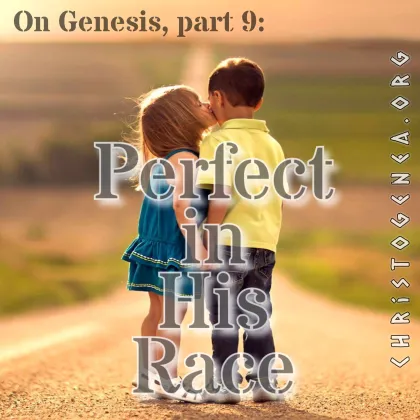
On Genesis, Part 9: Perfect in His Race
According to all of the evidence which we had discussed in our last presentation, The Giants and the Sons of God, we would assert that we have justification based on the merits of many valid reasons for our interpretation of the text of Genesis chapter 6. Therefore, where in the Masoretic Text it mentions “sons of God” in verses 2 and 4 of the chapter, we would amend it to instead read “sons of heaven”, or perhaps “angels”. Then where the popular translations have the word “giants”, we would interpret the Hebrew word nephilim to instead read “fallen ones”, which Wilhelm Gesenius himself had admitted was a valid reading, even if it was not the reading which he preferred, and as he also admitted, that it was also the choice of more than one presumably academic interpreter of the past. Doing this, the Genesis chapter 6 account is fully reconciled with the words of Yahshua Christ and his apostles in the New Testament, where if we ignore the witnesses which lead us to these conclusions, then Genesis remains in conflict with Christ and the apostles, or at the very least, it offers no support for many of their statements. But as Christians, we have an obligation to understand Genesis through the understanding which Christ has provided, and therefore we shall not disregard the evidence by which Genesis agrees with His words. This is what Paul of Tarsus had meant when he asserted that “16… we have the mind of Christ” in 1 Corinthians chapter 2, that word for mind describing the perceiving and understanding which we can have through His words. Therefore we have no obligation to cling to the Masoretic Text if valid and more ancient sources are found to better agree with the words of Christ.
In his one short epistle, the apostle Jude warned about certain men who had infiltrated the body of Christ, and admonished Christians to defend “the faith having been delivered to the saints”, whereafter he wrote: “4 For some men have stolen in, those of old having been written about beforetime for this judgment, godless men, substituting the favor of our God for licentiousness and denying our only Master and Prince, Yahshua Christ.” Here it is evident that first, these men can not in any way be appropriate candidates for conversion to Christianity even if they had entered and joined Christian assemblies. Then secondly, Jude is identifying them with “those of old having been written about beforetime for this judgment”, where it is evident that their origins cannot be from of Israel, or even from of God, as Christ had also said to His adversaries that “ye are from beneath” and “ye are not of God”, among other things which had denied them the claim that God was their father, as it is recorded in John chapter 8. These things, along with the Parable of the Wheat and the Tares and other things which had been explained by Christ, all make it evident that there was a race, or races, of men whose origin is other than that of Adam, and who were condemned from the beginning. So, speaking directly of certain men, Christ had also said that “Every plant which My heavenly Father has not planted shall be uprooted!” The only way to account for these things in Genesis is in our interpretation of this chapter, and in the identifying of the Tree of the Knowledge of Good and Evil and the Serpent of the garden with the fallen angels of Revelation chapter 12, which is also the identification provided by Christ Himself. Furthermore, where Jude wrote “those of old having been written about beforetime for this judgment”, he must have been referring to writings which are now deemed apocryphal, such as Enoch whom he cites later in his epistle, because these condemnations are not found explicitly on these same terms in our Old Testament canon as it is presently.
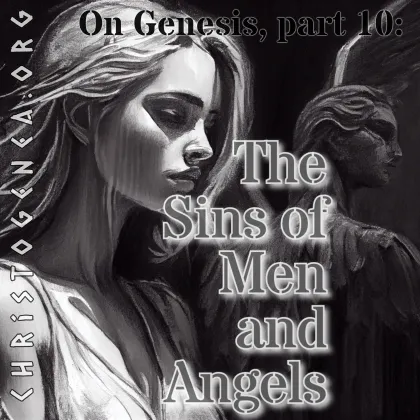
On Genesis, Part 10: The Sins of Men and Angels
The pitiful condition of the surviving portions of the Enoch literature and other apocryphal or pseudepigraphal works, such as the Genesis Apocryphon of the Qumran sect, may not present an absolutely reliable picture of all of the details of the sins of men and angels, but compared to the words of the apostles of Christ we may at least understand some of the underlying truths which they have preserved to some degree. So, as we discussed in our last presentation here, Perfect in His Race, the apostle Jude in his one brief epistle had warned of infiltrators into the Body of Christ who would introduce corruption, and had associated them with the fallen angels of antiquity. Both Peter and Paul had warned similarly. Then, as we had already mentioned in Part 8 of this commentary, Giants and the Sons of God, in Colossians chapter 2 Paul of Tarsus wrote in reference to the humiliation which is found in the worship of angels, where he must have been speaking of those same fallen angels. Then in 1 Corinthians chapter 10, speaking of the pagan worship of the nations of Roman Europe, he wrote “18 Behold Israel down through the flesh: are not those who are eating the sacrifices partners of the altar?”, and in reference to that same thing a little further on, he continued and wrote that “20 … whatever the Nations sacrifice, they sacrifice to demons, and not to God. Now I do not wish for you to be partners with demons.”
So in those two passages, Paul had equated the pagan religions with the worship of both angels and demons, and the meaning of his words cannot be completely reconciled with the writings of the Old Testament without the Enoch literature. So in Charles’ edition of 1 Enoch chapter 19 we read: “1. And Uriel said to me: ‘Here shall stand the angels who have connected themselves with women, and their spirits assuming many different forms are defiling mankind and shall lead them astray into sacrificing to demons as gods, (here shall they stand), till the day of the great judgement in which they shall be judged till they are made an end of.’” This in turn accords with the words of Christ, where we read in Revelation chapter 20 that the devil, the beast, and the false prophet shall be cast into the Lake of Fire, and in Matthew chapter 25 where He attests that the goat nations – those nations who are not His sheep – have their destiny in the “everlasting fire, prepared for the devil and his angels.” Only their origin explains the reason why they are not found written in the Book of Life.
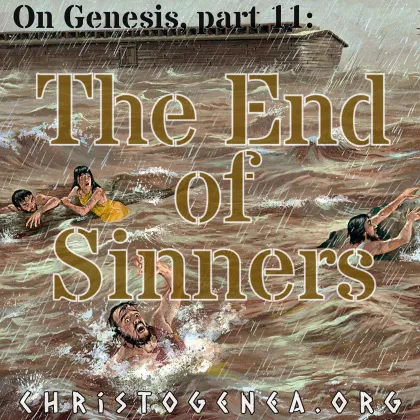
On Genesis, Part 11: The End of Sinners
Aside from the explicit description of fornication between the Nephilim and the daughters of Adam which is found in the opening verses of Genesis chapter 6, there are only implications and subtle indications in Genesis as to the full extent of the sins of men and angels. However since all flesh had become corrupted, according to verse 12 of Genesis chapter 6, and since not only the children of Adam, but even the beasts of the land had to be destroyed for that same reason, it is evident that there must have been some truth to the account of the treachery of the Nephilim in the corruption of the beasts underlying what is found in the Enoch literature. But evidently, Noah and his family had never taken part in those sins, as Noah was perfect in his race, which describes his sons as well as himself, and therefore their flesh had not been corrupted. So the Adamic man which Yahweh God had created would be preserved through Noah and his sons, while the rest of the race would be destroyed for their iniquity. Out of all the sins of men, race-mixing with another race, in this case the Nephilim, is the explicit reason given in Genesis chapter 6 for the destruction of the entire race of man.
Yet the Nephilim themselves were not entirely destroyed in the flood of Noah, where it becomes apparent that Yahweh God deals with fallen angels differently than he deals with sinful men. This is evident even in the King James translation of Genesis 6:4 where we read in part that “There were giants in the earth in those days; and also after that…” So while all of the children of Adam were destroyed except for the family of Noah, various of the descendants of the Nephilim are mentioned in Genesis chapter 15, Numbers chapter 13, and as late as the time of David, in the account of Goliath and his brothers 1 Samuel chapters 17 and 21 and 1 Chronicles chapter 20. These are some of the giants, or Nephilim, who were in the earth “in those days and after that”, referring to the time following the flood, and with that we also see that while the flood was evidently a far-reaching event, it was only a local flood, covering a limited region of the earth’s surface, and not the entire globe or planet. We certainly cannot assume that those Nephilim had survived on the ark of Noah, because Yahweh God brought the flood upon man for mixing with the Nephilim, and Noah was being separated and preserved because he did not mix with them, so having Nephilim on the ark would defeat the whole purpose of the flood. That is also the obvious reason why there is no mention of Nephilim on the ark.

On Genesis, Part 12: Solid Ground
Having discussed the onset, or perhaps, the onslaught of Noah’s Flood and The End of Sinners in Genesis chapter 7, we shall now move on to the aftermath of the Flood and the emergence of solid ground in chapters 8 and 9. However here the phrase solid ground relates just as much to our interpretation of the scope of the flood and subsequent events as it does to the experience of Noah. For one to acquire a proper understanding of the entire Bible depends upon a proper view of Noah’s flood. Claims that the flood covered the entire planet, that even the highest mountains on the globe were completely covered with water, are simply ridiculous and lead to very childish, and dangerous, views of the balance of Scripture. But these views persist, and have actually come to dominate denominational Christian thought, in spite of the fact that they are directly refuted by many passages and circumstances which are explained in Scripture itself.
At this point the denominational Christians may argue that races and cultures throughout the whole world have flood stories. But that does not mean that those floods were Noah’s flood, and since those races never had recorded histories, or even calendars, until they were encountered by Europeans, the dates of their own flood legends cannot even be determined. The truth is that numerous floods have impacted various regions of the world all throughout history. In 1931 in China, floodwaters as high as 53 feet covered approximately 69,000 square miles of land, put several large cities under water for several months, and the death toll is estimated from over 400,000 to as many as 4 million. But this was not Noah’s flood, and it certainly was not the first such flood in China. If it were not for the modern technology which the West had shared with China, perhaps many more Chinese would have died. Not that we care about Chinese, because they did not descend from Noah, nor from Adam, but this is only one example of many such historical floods.

On Genesis, Part 13: Thy Father’s Nakedness
Presenting Part 12 of this Genesis commentary, titled Solid Ground we hope to have elucidated from the situation of his descendants as it is described in Genesis chapters 10 and 11 and from the context of these chapters which describe the flood of Noah, that the most plausible location for the flood is the Mesopotamian Plain, and that the most likely landing spot for the ark after the flood is the foothills of Ararat which border that plain on the north. Here we should add one word of caution, that although we are confident of that assessment, we can never be absolutely certain given the relatively little information which we have in Scripture. But to this day, zealous denominational Christians and archaeologists both amateur and professional have sought Noah’s ark in the great heights of Mount Ararat, which has an elevation of over 17,000 feet. However we have found that the term ararat in Hebrew describes a mountainous region, and not merely a single mountain peak. The truth is that the ark must have landed on a foothill in that region, so that it would have even been possible for Noah, his family and the many animals with them to have survived after the flood, and that the wood from the ark either rotted away in its place, or more likely, it was repurposed by Noah and his family, or even others who lived in the region at a later time. The process of hewing logs into beams and planks by hand is quite arduous, and already-hewn logs from the ark would have been valuable for that reason alone. As we hope to establish later in Genesis, there are more than five hundred and thirty years between the time of the flood and the events of Genesis chapter 11 and the division of the sons of Noah, so it would be natural for his descendants to slowly spread into the plain south of Ararat, which is much more suitable for agriculture and husbandry than the mountains. As we have said, the site of ancient Babylon is about 250 miles from the southern edge of those mountains, and that is where the descendants of Noah are found in Genesis chapter 11.
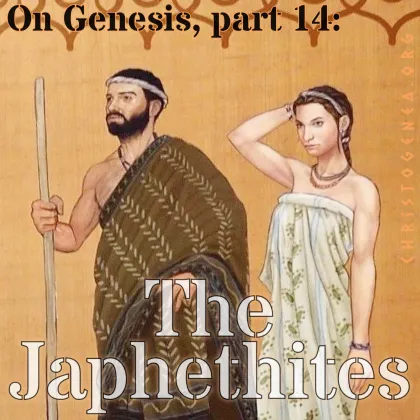
On Genesis, Part 14: The Japhethites
It was quite early in my Biblical studies when I had realized the importance of the table of nations descending from Noah which is found in Genesis chapter 10. The gravity of understanding the character of the nations which are listed in this chapter cannot be overstated. That is because Noah and his family were saved from the complete destruction of the children of Adam for one reason only: that they were perfect in their genealogies, which is their descent from Adam, or what we would call today their race, at a time when the balance of that race was described as having been corrupted, because they had committed miscegenation with the Nephilim. Therefore we must realize the importance of preserving that race, as it is the will of Yahweh God which He had expressed in the preservation of Noah. While we cannot preserve it without Him, as Christians we have a duty to love and to keep His commandments. This is indeed a Christian obligation, as Christ had said, where it is recorded in Matthew chapter 5: “19 Whosoever therefore shall break one of these least commandments, and shall teach men so, he shall be called the least in the kingdom of heaven: but whosoever shall do and teach them, the same shall be called great in the kingdom of heaven.” When He spoke those words, He was speaking in reference to the law and the prophets. That does not bode well for modern churchmen, who shall have no excuse for ignorance.
Any honest man who studies archaeology and history and who reads Genesis chapter 10 from the perspective of classical antiquity, where one must consider the nations of the sons of Noah in their ancient forms rather than in their modern conditions, must ultimately face the fact that all of the descendants of Noah were originally White, or what was called in the past Caucasian or considered to be related to modern Europeans. As a digression, the words of the prophets also explain the modern condition of those nations, and we may make some references in that regard as we discuss them here. In the 19th century, White Europeans were termed Caucasian because learned men who studied this aspect of history had realized that to a great extent, the early settlers of Europe had migrated from Mesopotamia and the ancient Middle and Near East by travelling through the region of the Caucasus Mountains. That view is oversimplified, but for many of our Keltic or Germanic or even Slavic ancestors it is certainly true. Others had come from the east at an even earlier time, in which most of them had migrated by sea rather than by land.
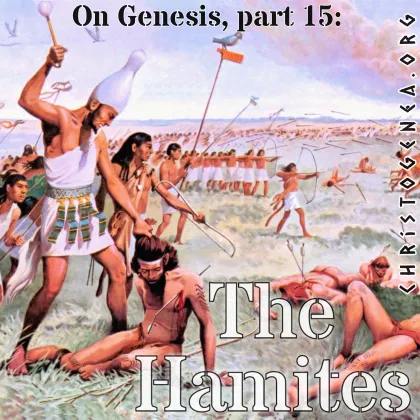
On Genesis, Part 15: The Hamites
In our last presentation where we had discussed the opening verses of Genesis chapter 10 we described the nations which can be identified with the sons of Japheth as they may be found in Biblical, historical and archaeological records. Now we shall endeavor to do that same thing with the sons of Ham, and then of course with Shem. Then after presenting the data needed to connect these Genesis 10 patriarchs to historical nations, we hope to have a supplemental discussion concerning the ancient characteristics of many of those nations.
But before proceeding here we shall briefly discuss some false reports concerning certain of the tribes of the Japhethites. There are popular Jewish so-called historians, notably Arthur Koestler, who have identified certain of the Turkic and other tribes who migrated from Central Asia into Eastern Europe in the historical period with tribes of the ancient Japhethites. In his book, The Thirteenth Tribe, Koestler cites a letter which was allegedly written by one Joseph ben Aaron, who is said to have been a 10th century king of Khazaria and one of the kings who supposedly converted to Judaism, who had identified the Turkic tribes as having been descendants of the Biblical Togarmah. Among these tribes he mentions the Uigur, Dursu, Avars, Huns, Basilii, Tarniakh, Khazars, Zagora, Bulgars and Sabir [1]. In the same book, Koestler explains the term Ashkenazi as it relates to Jews and says in part that “the term is misleading, for the Hebrew word Ashkenaz was, in mediaeval rabbinical literature, applied to Germany”, however he also states that certain “learned Khazar Jews” who had emigrated into Poland from Khazaria in the east had also called themselves Ashkenazim [2]. These claims, which had all evidently originated from medieval Jewish rabbis, are unsubstantiated. The rabbis in various places throughout the medieval world had often identified the nations whom which they had intercourse with Biblical tribes in a rather arbitrary manner, with no other basis for the identifications but their own poor opinions. Without archaeological evidence, or any supporting body of early literature, the various identifications are all mere conjecture.
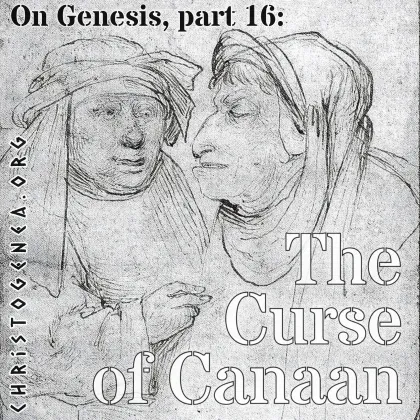
On Genesis, Part 16: The Curse of Canaan
In our last presentation of this commentary on Genesis we had discussed the first three of the sons of Ham, which are Cush, Mizraim and Phut. Now we shall discuss the youngest, or at least, the last one mentioned, which is Canaan. As we had explained when we presented Genesis chapter 9 and Thy Father’s Nakedness, since Canaan was cursed as a result of Ham’s having seen “the nakedness of his father”, as we read the account in Genesis chapter 9, then that phrase must have been a euphemism for another act, and therefore the birth of Canaan must have been the result of what is seen in the law in Leviticus chapter 20 where it says in part that “11 … the man that lieth with his father's wife hath uncovered his father's nakedness.” Having done that, we had also presented passages from Leviticus chapter 18 which further explain that the nakedness of a man’s wife is also the man’s nakedness.
But we cannot imagine that Canaan was cursed merely because Ham saw his own father naked, as we had also explained, with examples from Scripture, how in ancient times men had regularly seen one another naked even throughout the course of a typical workday, at least in certain vocations or activities. So that alone would not justify the curse of Canaan, but Noah certainly would have been justified to curse Canaan if Ham had violated his wife, which was also Ham’s own mother, and if Canaan was the result of such a union. Subsequent events in Scripture also justify Noah’s curse of Canaan, as Yahweh had upheld his words so that they became prophetic of the fate of Canaan. When Yahweh upholds a man’s words, it is because the words are just and the man had uttered them righteously. This we read of the young prophet Samuel, in 1 Samuel chapter 3: “19 And Samuel grew, and the LORD was with him, and did let none of his words fall to the ground.”
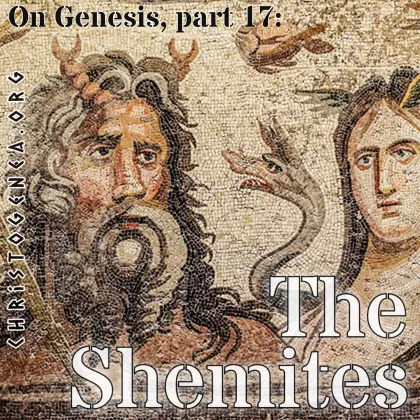
On Genesis, Part 17: The Shemites
In our recent discussion of the Hamites and the description of Nimrod and the first Adamic empire, of which ancient Akkad was a part, we had discussed the first Akkadian empire and the presence of a historical Cush in Mesopotamia in the 3rd millennium BC. Then in our separate discussion of the accursed tribes of the Canaanites, we had described the rise of several Canaanite empires in the early 2nd millennium BC, namely the Babylonian Empire of the Amorites, the Hittite Empire, and the Mittani Kingdom of the Hurrians. These Canaanite empires were relatively short-lived, as compared to those of Egypt and Assyria, but it is quite possible that they were not the only Canaanite empires which existed in ancient history.
For example, there is ancient Ebla, the importance of which was not even discovered until the site of the city was excavated after its discovery in 1964. Evidently, Ebla had dominated what is now northwestern Syria from the mid-to-late 3rd millennium through most of the 2nd millennium BC. Ebla was about 34 miles southwest of Ḥalab, or Aleppo, which is said to have been the seat of another kingdom, Yamhad, although it is apparent that the empires of Yamhad and Ebla had each covered the same general territory at the heights of each of their power, along the coast of the Mediterranean Sea in modern northwestern Syria. As a digression, in this sense an empire is only a city-state which subjects to itself other city-states within a particular region, whose inhabitants were not necessarily of the same tribe, and these empires were quite small compared to the empires of later history.
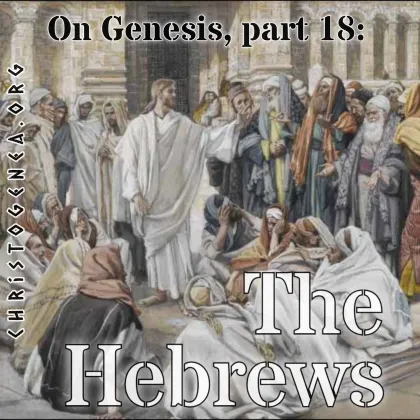
On Genesis, Part 18: The Hebrews
In our last presentation, The Shemites, we had asked a few questions which we had only answered in part, such as “what defines a Semite? And what is a Hamite, or a Canaanite?” Those we answered by stating, perhaps in different words, that the only proper classifications of those people are along Biblical terms, in agreement with Genesis chapter 10, since Genesis is the very source of those terms. But then we also asked another question, which is related to these because of the manner in which modern academic sources classify languages, and that is “what language is Hebrew?” This question we shall address presently, before proceeding to discuss Eber, the first Hebrew.
All throughout the Christian epoch, the history of the ancient Near East has been viewed through exclusively Jewish eyes, and this has had a profoundly damaging impact not only on Biblical studies, but on all modern historical, archaeological and linguistic inquiry into the cradle of civilization found in ancient Mesopotamia and the Levant. But as Paul of Tarsus had also explained, in 2 Corinthians chapter 3, the Old Testament cannot even be understood unless one is a Christian, and therefore no Jew can possibly understand it. But Christians, if they follow Jews, they will also fail to understand it, as Christ had said of the Pharisees of His Own time, in Luke chapter 6, “39 … Can the blind lead the blind? shall they not both fall into the ditch?” Collectively, Jews have innate biases which naturally restrict their understanding, and lead them to errant identifications and faulty conclusions regarding history, language and archaeological findings, along with a tendency to pollute everything they study with their own Talmudic reasoning, which is always naturally antithetical to God.
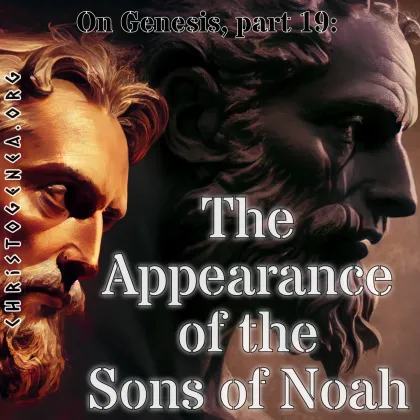
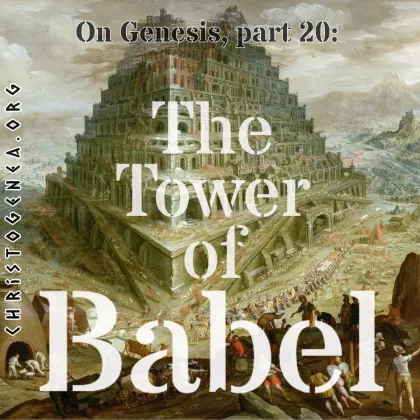
On Genesis, Part 20: The Tower of Babel
The Roman Catholic, Orthodox and denominational churches have for centuries upheld the myth that all races of hominids on this planet have come from Adam, and that the various races were derived from the different sons of Noah, actually asserting that Noah’s sons had each spawned different races of so-called man. Doing this, they blatantly ignore the fact that the ancient Hebrews had several words for man, including adam, enosh and ish, and that they applied those words only where they were appropriate. The word adam describes a particular race of man, which today we call White, and these are the men who descended from Adam through the sons of Noah. The word enosh describes a mortal man, an adult male hominid, without any connotation of race. They also ignore the fact that there were other so-called men in Scripture who were not descended from Adam, such as the Nephilim and several other groups which are mentioned later, in Genesis chapters 14 and 15. No Nephilim could ever properly be called an adam, but either the sons of Adam or the Nephilim could be referred to as enosh. The later Greek, English and other languages lost this important distinction, and the churches willfully ignore it.
In our last presentation in Genesis, The Appearance of the Sons of Noah, we hope to have sufficiently demonstrated the truth of our assertion, which is that if it can be proven that any one of each of the nations of the families of Shem, Japheth and Ham were originally White, then it must be accepted that all of the sons of Noah were originally White, in spite of the conditions of any of those nations today. Doing that, we presented solid, and even irrefutable, evidence from ancient literary, archaeological and scientific sources demonstrating that the ancient Cushites were White, the ancient Egyptians were White, the ancient Canaanites were White, at least apparently, the ancient Ionians, or the sons of Javan in Genesis chapter 10, were White, the ancient Elamites or Persians were White, the ancient Syrians of the north of modern Syria and Anatolia, whether they were of Aram or Asshur or some other Biblical tribe, were White, and that other Genesis 10 families, such as the Assyrians, Aramaeans, Medes, Arians and others, were also White because the ancient records attest that they were homogeneous and physically indistinguishable from these others.
Christogenea is reader supported. This month's support level is reflected in the graph below. See our Contact page for a mailing address and other ways to support Christogenea.
87%